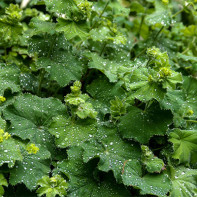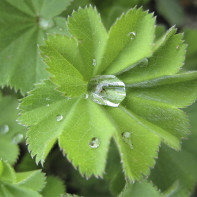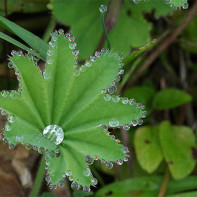Cuff: medicinal properties and contraindications
This herb has many names. In the reference books it is a common cuff, but folk names are much more poetic - for example, spell-grass, God's teardrop, heavenly dew or star-grass. In the olden days, it was also called the alchemist's herb. Indeed, this perennial herbaceous stalking plant has many useful properties. It has anti-inflammatory, expectorant and choleretic effect, has antiseptic properties and is able to stop blood. Although cuff has not been officially recognized as a medicinal plant, it is widely used in the industry to produce dietary supplements.
- Chemical composition
- What it looks like and where it grows
- Types
- Harvesting and storage
- Therapeutic properties of the cuff herb
- For Women
- For Men
- In pregnancy
- For children
- When losing weight
- The use of cufflinks in folk medicine
- Kinds of medicinal compositions with cuff
- Infusion
- Infusion
- Decoction
- Tea
- Cosmetic applications
- Contraindications to use
- Interesting Facts
Chemical Composition
All the medicinal properties of the common cuff are not badly studied. They are all explained by the chemical composition of its roots, herbs and leaves. Some of the most important ingredients from a medical point of view include:
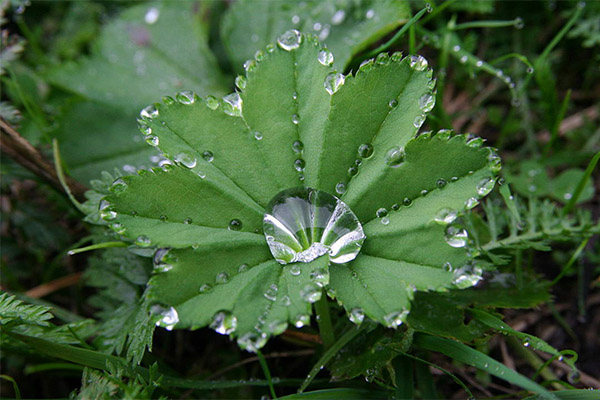
- Tannins are mostly tannins, the most contained in the roots, in the leaves and stems - only up to 3%.
- Catechins are flavonoids that have antioxidant properties.
- Steroids are hormone-like substances of plant origin.
- Lignin - having a positive effect on the microflora of the large intestine.
- Lecithin - used in the manufacture of hepatoprotectors because it helps protect liver cells.
- Ascorbic acid (vitamin C) - beneficial to the circulatory system.
- Various macro- and micronutrients, including zinc with its anti-inflammatory properties, boron and manganese.
The plant also contains oleic, phenolcarbonic, linoleic and other acids, lipids, coumarins, glycosides.
How it looks and where it grows
In modern phytotherapy, cuff is most commonly used. This is a herbaceous low-growing plant with relatively slender stems, creeping along the ground. During the flowering period, they rise up slightly. The cuff grows up to 30 cm in height.
The rhizome of the plant is quite powerful, located horizontally. Leaves at the root grow large, slightly wavy. But the leaves on the stems are distinguished by their semicircular shape. They are pubescent on both the front and back sides, have serrated edges. In general, the shape of the leaves is interesting in itself. At the base they seem to curl up into a funnel, allowing them to retain precious moisture.
Moreover, on the edges of the leaves are hydatodes, special glands which secrete liquid in droplets so that the plant gets rid of excessive moisture. This process (guttation) is mostly characteristic of tropical forests with their high humidity and low light. In temperate climates, this feature is rare, and the cuff is one of the few examples of it.
Interestingly, the dense pubescence also protects the plant from overwatering because it keeps the leaves almost completely dry even after a rain.
The cuff blooms twice a year (under favorable conditions). The first time this occurs in early summer, the second flowering is possible in early autumn. Flowers it has small, pale green shade, gathered in narrow inflorescences, the shape more like balls (although in botany such is commonly called a corymboid panicle). Fruit-seeds of the cuff are formed in August.
Types
There are several varieties of cuff, but not all of them are used in medicine. Some are bred mainly for decorative purposes. Widely distributed are:
- Soft cuff. This variety of plant is found both in Eastern Europe and in Asian countries - Turkey, Iran, etc. It is a fast-growing climbing plant with beautiful yellow inflorescences. It grows in clumps up to 40 cm high - and about the same width. When its openwork inflorescences appear on it, which usually happens in June, such a bush looks very lush and spectacular. Cufflinka soft is used mainly in landscape design, in the garden it is often planted near ponds, in borders and mixed flower beds. In floristry, it is included in bouquets to make floral compositions more lush.
- Alpine cuff. It is found in fairly harsh climates, in Greenland and Northern Europe. This species prefers calcareous and stony soils. From other species this cuff differs even in appearance. Its leaves are deeply parted and on the underside they are covered with very light, silvery fuzz, which makes them appear to have a white frame. This makes the plant look very decorative even outside the flowering period. It is used mainly in landscape design - it is planted in rockeries, also effectively look container plantings in company with hyacinths and tulips.
- Red-cheeked cuff. This variety is also often found in high mountain meadows. In nature it grows in the Crimea, the Bulgarian Rhodopes, the Caucasus and the western part of the Carpathians. It differs from other species by its very small size, not exceeding 15 cm in height. In addition, this cuff has a characteristic bluish-green shade of leaves attached to the stem with reddish petioles. This variety is also often used in landscape design, planting in rockeries. But this cuff can also look good in border plantings.
The listed varieties are mainly grown in gardens. But, in addition, in the middle belt of Russia there are many wild varieties. In general, there are more than 30 species of this plant. For example, in dry areas one can find mountain, glaucous and globular-twisted varieties. Also in arid areas, the tuberous cuff grows. In shady woods and humid conditions the semi-lunate and wave-leaved varieties grow, while in marshy areas the holostebel.
There are also varieties that are equally good on dry and wet soils (e.g., bristlecone). But still the most common variant is the common cuff. And it is it that is used in folk medicine and in the pharmaceutical industry.
Gathering and storage
In phytotherapy, both the grass of the cuff and its rhizome are used. The above-ground part is harvested from the second half of May until mid-summer. Grass may be harvested only during daylight hours, taking into account the abovementioned guttation effect; you must wait until the morning dew and moisture have dried out.
The herb should be cut together with leaves, shoots and flowers with a sharp knife. Dry these raw materials in the shade, preferably in a room with good ventilation. You can also use special dryers. However, in this case you need to set the most gentle temperature mode - no higher than 60 degrees. Dried grass and flowers should be stored in paper or linen bags until next year, no longer, because over time the grass will have a very unpleasant bitter taste.
The roots of cuffs are also harvested for medicinal purposes. But it is recommended to dig them out already in early autumn. There is no need to wash them, just peel them gently from the ground. Dry them also in the attic. Store such raw materials in cloth bags for no longer than 2 years. Like any other medicinal plants, the cuff is kept in a dry and dark closet, away from the heat source, so it does not deteriorate under the influence of sunlight and high temperatures.
Therapeutic properties of the herb cuff
The unique chemical composition of this plant has determined its medicinal properties. That is why the "alchemist's herb", as cuff was called in the old days, acts in this way:
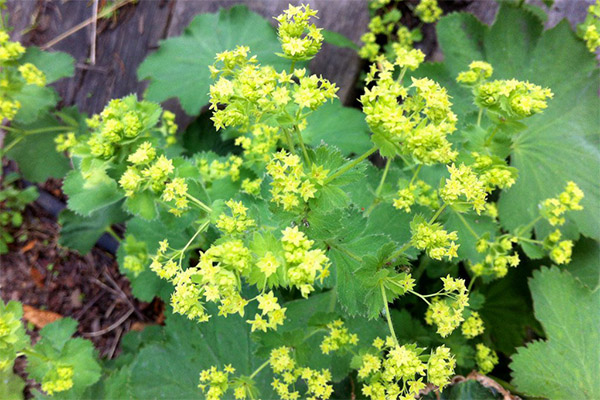
- Stimulates the production of progesterone, the female sex hormone. This is due to the high content of plant steroids. These properties have been confirmed by scientific studies conducted in St. Petersburg. The ability to influence the hormonal balance makes the cuff an effective remedy for dysmenorrhea.
- Regulates metabolic processes - also due to the content of steroids, lipids and several other substances.
- Normalizes the cardiovascular system.
- Strengthens the body's natural immune system.
- It has antiviral activity - virologists have proven its effectiveness in the fight against influenza. This property is due to the action of flavonoids, which are strong antioxidants and also have an anti-inflammatory effect.
- It has not only anti-inflammatory but also rejuvenating effect and removes toxins due to the presence of lignin in its composition.
- It speeds up tissue regeneration and heals burns and cuts thanks to the high content of coumarins.
Cuffs are only so called, but in fact this herb is unique in many ways. Means on its basis not only heal wounds and strengthen capillaries, but also accelerate regeneration and are effective prevention of heart attacks and a number of vascular diseases.
For women
For the fairer sex, cuff is useful because it contains steroids. These are plant analogs of female sex hormones. In this case, unlike synthetic means used in hormone replacement therapy, infusions and decoctions of cuff are practically free of contraindications and side effects.
Mainly cufflinka-based remedies are used for dysmenorrhea, that is, failures of the menstrual cycle, but they can be effective in the menopause. And their anti-inflammatory properties make them a great remedy for many pelvic diseases.
For men
For the representatives of the stronger sex, the anti-inflammatory properties of the cuff are also important, because remedies based on this herb can be used in the treatment of prostatitis and urethritis. But much more important for them is the ability of the herb to strengthen blood vessels and regulate the level of "bad" cholesterol, because men are more at risk of cardiovascular disease than women.
In pregnancy
In folk medicine it is believed that decoction of cuff herb or less concentrated tea of this plant should be drunk when there is a threat of miscarriage. Also many herbalists recommend taking such remedies for severe toxemia in the first trimester or for abdominal pain. However, you can drink such herbal decoctions only after consulting a doctor, especially since the pain can be associated, for example, with ectopic pregnancy.
In the olden days women in labor were given decoction of cuff immediately before delivery, to facilitate the process, but in modern conditions in maternity hospitals this is not encouraged, in addition, there are more effective medications.
Cuff is also considered a good remedy for lactation, many advise her to take young mothers trying to establish breastfeeding. But you need to be careful and first make sure that the child is not allergic to such infusions and decoctions.
For children
Although the cuff is considered a good anti-inflammatory and expectorant, it is not recommended for the treatment of young children. Some pediatricians believe that it should not be given to preschoolers at all, but to teenagers it can be useful for strengthening muscles and joints. In addition, teenage girls are given decoctions and infusions of cuff to relieve menstrual pain and to adjust the cycle.
For weight loss.
Steroids, lignin and lecithin are components that make cuff grass effective for weight loss as well, as it helps to establish the metabolism. In addition, this herb contains phenolcarboxylic acid. It has unique properties - first, it has a warming effect, and secondly, it improves vascular permeability. It also improves circulation and metabolism, especially since the phenolcarboxylic acid action is reinforced by the flavonoids and tannins that make up the plant. Among other things, they have a rejuvenating effect and make the skin smoother and firmer, so that the cuff is also used to treat cellulite.
For weight loss, the most effective is considered a tea based on this herb, which will be described below. But from cellulite it is better to make compresses with decoction of cuff.
The use of cuff in folk medicine
Although there are more than five hundred varieties of this plant in nature, only the common cuff can be useful for phytotherapy, but it is effective in a variety of pathologies:
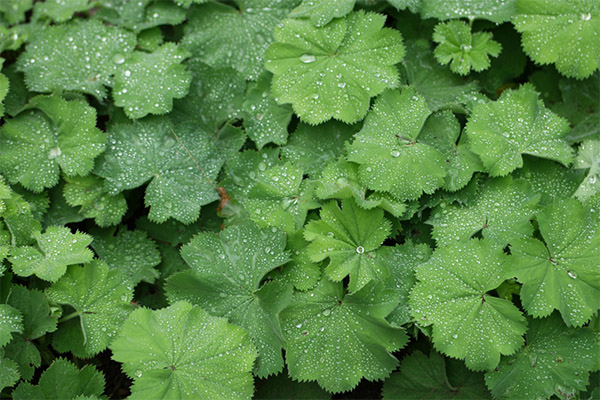
- With inflammatory uterine diseases, it is recommended to drink a decoction of the herb and leaves of the cuff - 0.5 liters per day, divided into three equal portions. You can add a little honey to improve the taste. This remedy is also considered effective for the restoration of the uterus after heavy childbirth.
- With amenorrhea (painful menstruation) is recommended to drink 400 ml of decoction cuff per day, divided into two doses - in the morning and in the evening.
- With migraine and headaches provoked by high blood pressure, you can drink a cup of tea based on cuff per day.
- For the treatment of purulent wounds and cuts is used cuff infusion, on the basis of which make compresses and lotions.
- In some inflammatory diseases of the pelvic organs, an infusion or decoction of cuff can be used for vaginal douches.
- In the treatment of hemorrhoids, the cuff is good for its complex action. It stops the blood, promotes tissue regeneration, strengthens blood vessels. For this purpose, cuff infusion is used, which is impregnated with special tampons.
- In anemia and atherosclerosis it is recommended to take a decoction of the leaves of this plant, which is infused in grape wine. This remedy is also considered effective for heart pain.
- With chronic colitis out of periods of exacerbation is recommended to take 10-15 drops of an alcoholic tincture of cuff per day (dilute them with a little water).
- In diabetes, it is recommended to take 200 ml of decoction cuff daily. But only, unlike the treatment of other diseases, you can not add honey here.
- In the treatment of cut wounds, you can use fresh leaves, which are lightly rubbed in the hands so that they let out the juice. This green mass should simply be applied to the damaged area of the skin.
The listed cases are not the only uses of cuffs. This plant can be used to expel phlegm in bronchitis of different origin, in other respiratory diseases, including pneumonia. In addition, decoction of the herb is used to gargle the mouth with stomatitis, from it do lotions with conjunctivitis (if this disease has a bacterial origin, the cuff is used in addition to therapy with antibiotics, but not instead of it).
Types of medicinal compositions with cuff
On the basis of this plant make remedies for both internal and external use. The most common option is an aqueous extraction of useful substances, that is, decoctions and infusions. However, some herbalists for the treatment of diabetes and obesity recommend taking a powder of crushed herbal raw materials.
As for remedies for external application, it can be various compresses, poultices, applications. They use not only infusions and decoctions, but also the juice of the cuff. It is pressed from the young leaves and shoots. Such a remedy can be used to treat acne by diluting it with milk in the proportion 1:10. The juice is also suitable for internal use - for example, it is drunk with diarrhea (every 2 hours, 1 tsp. remedy).
Infusion .
This product is prepared as follows - take 3 tsp. chopped grass and cuff leaves and pour 250 ml of boiling water, and then leave for 2 hours under a lid. Then the infusion is strained, with the remaining plant material is squeezed.
The resulting infusion is considered a fairly concentrated. It is used in the treatment of heavy menstruation, also relieves inflammation in various purulent diseases. In the latter case, on its basis make baths and poultices. Compresses with cuff tincture alleviate the symptoms of varicose veins, although they do not completely eliminate its causes.
In some cases, the infusion is made less concentrated - take 3-5 tbsp. Raw materials to 1 liter of boiling water, bring to a boil and kept on low heat for another 10-15 minutes. Then insist for an hour. This herbal infusion can be drunk for weight loss, combining it with sports activities.
Tincture .
Unlike many other tinctures, a remedy based on cuff is made not on alcohol, but on wine. It should take 1 tsp of dry milled plant material in 170 ml of wine. Tincture means fast - for a day (for this leave it in a dry and dark place). Before using the finished tincture is filtered through two layers of gauze. Take it with atherosclerosis and other diseases.
Decoction
Decoction of the cuff is considered an excellent antiseptic. In addition, it has astringent and expectorant properties, and a number of studies have shown its sedative effect. It is mostly taken internally. But thanks to its antiseptic properties, it can also be used as an external remedy - for example, for acne.
To prepare the traditional broth takes 4 tsp of crushed herbs in 250 ml of boiling water, once again bring to a boil and keep on the heat for another 5 minutes. After that, the broth is left to cool, pass through gauze or filter paper and use as an internal or external remedy.
A wine decoction is also prepared on the basis of the cuff herb. Take 30 grams of crushed dried stems and leaves for 1 liter of red wine and heat for 10 minutes. This remedy is taken by 3-5 tablespoons per day before meals. It helps get rid of diarrhea (provided that it is caused by dysbacteriosis or intestinal infection, if even after a month of this treatment its symptoms persist, you should consult a doctor).
Cuff root is used to make a wine decoction. For 20 g of dried herbal raw materials take a glass of wine, bring it to a boil and leave for another 30 minutes over medium heat. The finished decoction is passed through several layers of gauze to get rid of pieces of the root. There is also another version of this recipe. Decoction of the root is prepared separately, taking a very small amount of water, then add wine and heat it, but do not boil it, in order to preserve all the useful substances as much as possible.
Such a remedy can be taken 2 tbsp. a day for 30 minutes before a meal for anemia, it is also considered effective for dysbacteriosis and meteorism provoked by it. Nutritionists consider this wine decoction an excellent way to speed up the metabolism.
Tea
On the basis of this plant is also cooked tea - it is brewed the same way as the traditional drink of tea leaves, that is, 1-2 tsp of crushed dry raw materials pour a glass of boiling water, insist for 10-15 minutes and then filtered. Tea is mainly taken as a restorative, in addition, it is good for insomnia. Some herbalists recommend giving it to children for the prevention of rickets, but it is still better to consult a pediatrician, because modern doctors believe that in children it can cause allergies.
Use in cosmetology
Cuff is not considered a "female" herb for nothing. It is useful not only for treating diseases, but also for home beauty treatments. Powder from the dried leaves of this plant can be added to ready-made cosmetic masks and lotions, as it also has an antioxidant effect and helps to stop premature skin aging.
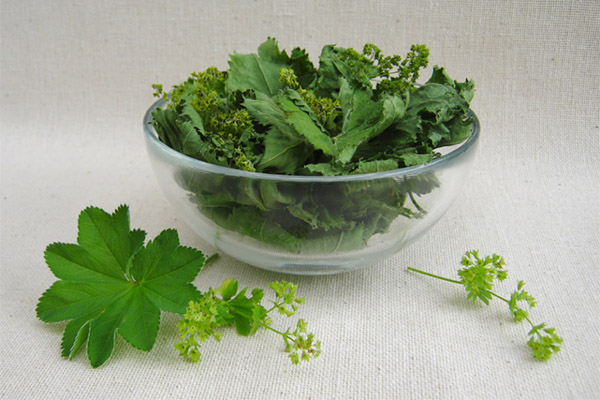
In home cosmetology most often used decoction of cuff. It is recommended to prepare in summer and freeze in ice molds. The resulting cubes are used for facial massage. This helps to increase skin elasticity, make it smoother, improve its oxygen supply by increasing microcirculation.
With acne, the most commonly used infusion of cuffs - as lotions or lotions. However, more effective is considered an ointment made from an alcoholic tincture of cuff (10-20 ml of finished product - it is sold in pharmacies), mixed with petroleum jelly (up to 90 g). This ointment is considered effective for solitary acne and boils.
Cuff will also be useful for strengthening the hair, because their condition directly depends on the hormonal balance. You can add an infusion or decoction of this herb to the water prepared to rinse your hair. Or you can make a decoction based on the following plant collection - for 15 g of dried grass cuff take the same amount of nettle herb and twice the amount of crushed dried burdock root. All this pour 1 liter of water and bring to a boil, boil for 5-7 minutes, then cool and insist for 45-60 minutes. The resulting product can be added to water to rinse curls or rubbed into the scalp instead of lotion. Its regular use strengthens hair follicles.
In some recipes, birch leaves are added to this collection, this helps to make the remedy effective also against seborrhea.
Contraindications for use
One of the advantages of cuff is that this herb has almost no contraindications. It should not be taken only in the presence of allergic reactions and individual intolerance, as well as high blood clotting. It is prescribed with caution during pregnancy and lactation - only after all investigations and consultations with the doctor, because an overdose of even herbal steroids can have a negative impact on the body.
Interesting facts
- Cuff looks humble, but in fact belongs to the famed family of Pinks. In botany, it bears the name Alchemilla, derived from the word "alchemy" - this is an ancient science, whose adepts were looking for the philosopher's stone and the elixir of eternal life. The therapeutic properties of this herb were already known at that time, and ancient scholars believed that the plant's ability to secrete fluid indicated its magical nature. Drops of morning dew, which were collected in a natural funnel formed by the leaflets, were especially valued.
- Practice has shown that the cuff really has a lot of useful properties and is able to get rid of a variety of pathologies, although there is no magic in it, of course.
- The Russian name of this herb, which is actively used today, arose because of the resemblance of the leaves of this plant to the lush lace cuffs fashionable in the gallant age. But in England and Germany, people saw in their form a resemblance to the cape of the Virgin Mary, hence the name "cape of the lady. In almost all countries of Western Europe, this herb was attributed witchcraft properties. For example, it was believed that the dew collected in the leaves helped restore youth, and also - gets rid of acne, freckles and age spots.
- Interestingly, the cuff can be used in cooking, usually for this purpose take the leaves of the plant, sometimes - young shoots. In early spring, this herb can be added to leafy greens salad, soup or green borscht. Sometimes it is harvested as a condiment. For this purpose, it is dried in the way described above, because it allows you to save almost all the useful substances, and in the winter it can be added to both soups and second courses. And it is also a useful vitamin supplement, as it contains a large amount of ascorbic acid. In Eastern cuisine, the leaves can be salted together with other spicy herbs or vegetables.
«Important: All information on this site is provided for informational purposes only for educational purposes only. Consult with a health care professional before following any recommendations. health care professional before using any of the information on this site. Neither the editors nor the authors shall be liable for any possible harm caused by materials."

